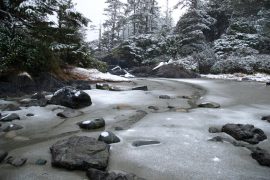Proverbs 24:27 – “Prepare your work outside, get everything ready for you in the field; and after that build your house.”
Welcome to Your Work Outside
If you’re reading the EcoTheo Review then chances are you not only like to be outside, but you get some spiritual satisfaction from nature. Enjoying a hike in the woods or watching a hawk soar overhead makes you feel closer to God somehow; firsthand experience with His Creation touches your soul in a different way than worship. Of course, God asks a little more of us than just enjoying nature and feeling good – He made us stewards of his Creation. All of it. From the small-footed bat to the white rhino, from the creek in your backyard to the Arctic. And stewardship in the 21st Century involves a lot of work. Environmental issues face us every day, and each one of us must make an effort to work on those problems. No matter how daunting or hopeless it may seem sometimes, we owe it to our children, ourselves, and our God to keep his Creation healthy. He gave us a job to do. As a field biologist I spend a lot of time working on conservation issues, and as a Christian I spend a lot of time thinking about how those issues relate to my faith. This column will share some current conservation issues in a Christian context, particularly threats to rare species and habitats. When possible I’ll also try to focus on how you can help address conservation issues in your own community. After all, we can’t build a strong house until we do our work outside.
Ecological Armageddon?
“Ecological Armageddon.”[ref]http://www.sciencedaily.com/releases/2013/09/130926143141.htm[/ref] That’s how the lead researcher described the results of a twenty-five year study on the devastating effects on habitat fragmentation on native species. Just published in the journal Science, the study focused on the impacts on small mammal populations after construction of a large hydroelectric reservoir in Thailand broke a large forested area into many small, disjunct forested patches.[ref]L. Gibson, A. J. Lynam, C. J. A. Bradshaw, F. He, D. P. Bickford, D. S. Woodruff, S. Bumrungsri, W. F. Laurance. Near-Complete Extinction of Native Small Mammal Fauna 25 Years After Forest Fragmentation. Science, 2013; 341 (6153): 1508 DOI: 10.1126/science.1240495[/ref] For decades conservation biologists have known that chopping up large, intact ecosystems into a bunch of bite-sized chunks is bad news for many species dependent on those particular ecosystems, due to the edge effect and other factors. For instance, say you are a hooded warbler, a little neotropical songbird that nests in forestland shrub thickets in the Eastern U.S.—even though the study in question was about small mammals, the principle is the same for any species dependent on its habitat niche. If your shrub is close to the edge of the woods, near a field or open area, it is probably a little easier for a predator to find you and gobble you up, a cowbird to find your nest and destroy your eggs, or even for an invasive plant species to take over your shrub’s habitat and leave you without a home. However, if your shrub is in the middle of a large forest you are a little more secure from predators because there are probably plenty of similar shrubs where you can hide, you are more likely to find enough to eat and find a mate because you are surrounded by appropriate habitat instead of pushed up against a wall of unsuitable habitat (meaning the field next door), and invasive species are a little less likely to find you that far away from their own source population. Common sense says that a 20,000 acre forest surrounded by open land has a lot less “edge” than ten 2,000 acre forests with farms in between them, not to mention that a 2,000 acre forest just simply doesn’t have as much contiguous forested habitat for very many individuals to set up territories.
Many conservation biologists advocate the creation of corridors of suitable habitat to link disjunct ecosystems; for example, planting a 100 foot wide strip of trees from one of our 2,000 acres forest patches to another to create a little highway of forested cover, therefore tying all the forest patches together and allowing critters to travel from one patch to another without getting out of their preferred habitat. The assumption is, of course, that the species dependent on these habitats survive long enough for the trees in the corridor to grow up and provides cover (or the artificial wetland to be constructed, or the prairie grasses, whatever the case may be). Unfortunately, this Thailand study indicates that some species can’t wait long enough for all that corridor building to be effective. After the large forest block in the study was fragmented into small forest patches by construction of the reservoir, many native mammal species disappeared so quickly that after 25 years only one individual per patch remained—obviously not enough to mate and maintain a viable population. The problems created by this fragmentation were not unexpected, only the speed of the decline was surprising. Main culprits in the decline of native species included lack of enough territory to go around and increased competition by the invasive rats that usually prefer farms to forests (and were accidentally introduced to the farms by humans in the first place, like rodent pests everywhere in the world). The lesson is that as soon as the big forest was chopped up, populations began crashing to seemingly unrecoverable levels. Like any field study the results from this specific location may or may not apply to other cases, but they are pretty eye-opening. “The bottom line is that we must conserve large, intact habitats for nature,” said Luke Gibson of the University of Singapore. “That’s the only way we can ensure biodiversity will survive.”
Gibson was also the one who used the term “ecological Armageddon” to describe this drastic decline in native species populations due to habitat loss. His use of Armageddon really made me stop and think about how common “end of days” rhetoric is in the conservation community. Folks use terms from the Book of Revelation so often when being gloomy that they obscure the biblical meanings. Catholics and mainline Protestants typically don’t spend a lot of time talking about Revelation (or the “Book of the Apocalypse” as my family’s old Douay Bible calls it); it’s open to way too much interpretation, takes too much focus away from the Gospels, and is just plain weird. Personally, I can never figure out the difference between the horseman with the bow and the one with the sword. While eschatology is not my strong point, my Sunday school understanding is that the Apocalypse as a whole represents the unavoidable and ultimate triumph of God and the creation of a new and better world, while Armageddon is an unfortunately tumultuous and violent part of the process. More specifically, the Apocalypse includes the entirety of John’s Book of Revelation in all its gloriously convoluted prophetic imagery—from the broken seals to the lampstands to the horsemen to the dragons—while Armageddon is a small part of the Apocalypse, the battle between God and the forces of evil at Megiddo. Perhaps “ecological Apocalypse” would have fit his small mammal doomsday metaphor a little better, although that isn’t exactly right, either. If you accept Revelation as a prophetic book, then the Second Coming and all that comes with it is all in God’s hands. It isn’t really like the movies where you can stop the “End of Days” by cracking the Revelation code and preventing one of the seals breaking and maybe fight Beelzebub with a machine gun (definitely not one of my favorite Schwarzenegger movies; give me Conan any day). We can’t know the hour or the day, but it is unavoidable, and we really don’t have much of a role in it. We aren’t going to cause or prevent it, we just have to be ready for it.
So what does the Apocalypse have to do with the habitat loss and species decline it the Thailand study? Not much, and that is my point. None of the seven seals unleashed urban sprawl. Habitat loss and species decline are not preordained or unavoidable. They are not part of God’s plan. They are an unfortunate result of mankind’s unwillingness to care for the Earth and all that is in it, all the things God created and proclaimed “good.” If the results of this particular study are valid for ecosystems worldwide, they would indicate that after we fragment or reduce any large ecosystem we may not have time to repair it before resident species disappear, even through corridor building. If that is true then many species’ only hope for survival is our conservation of large, intact habitats before they are fragmented, just as Dr. Gibson suggests. Unlike Armageddon and the Apocalypse, Christians can have a role in conservation efforts today, right now. From our national parks to your local nonprofit land trusts, there are many committed people working to protect the natural areas we have left, those that haven’t been fragmented beyond recovery. You can find and help your local land trust by clicking here. These groups need more assistance from similarly committed Christians, and we can all help avoid this particular “Ecological Armageddon”.





